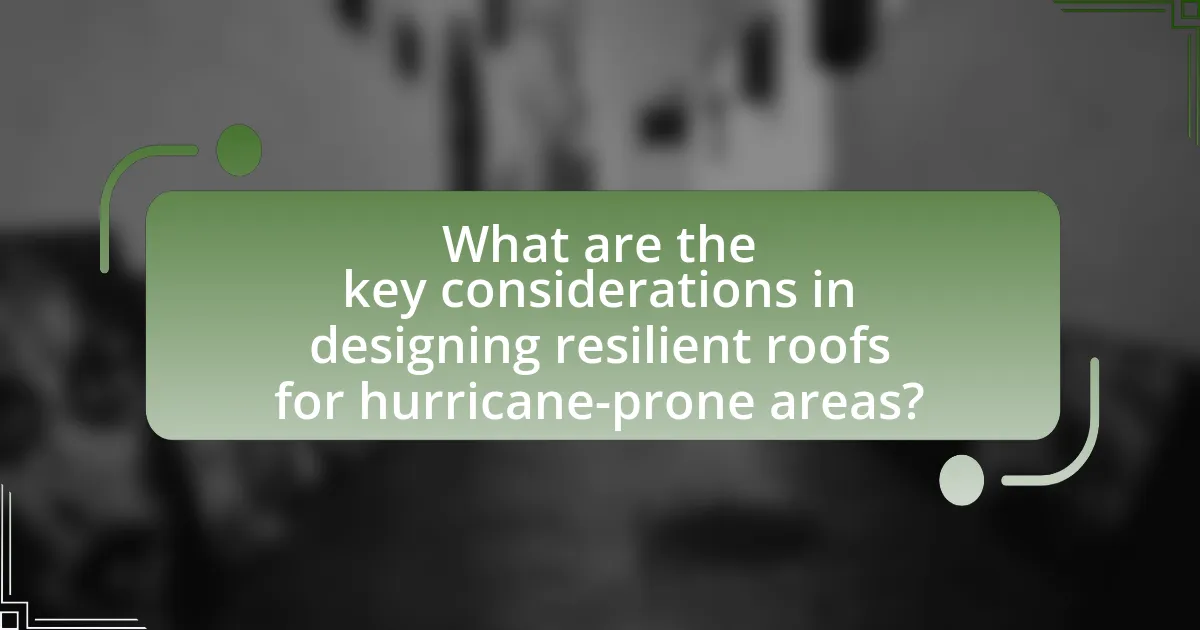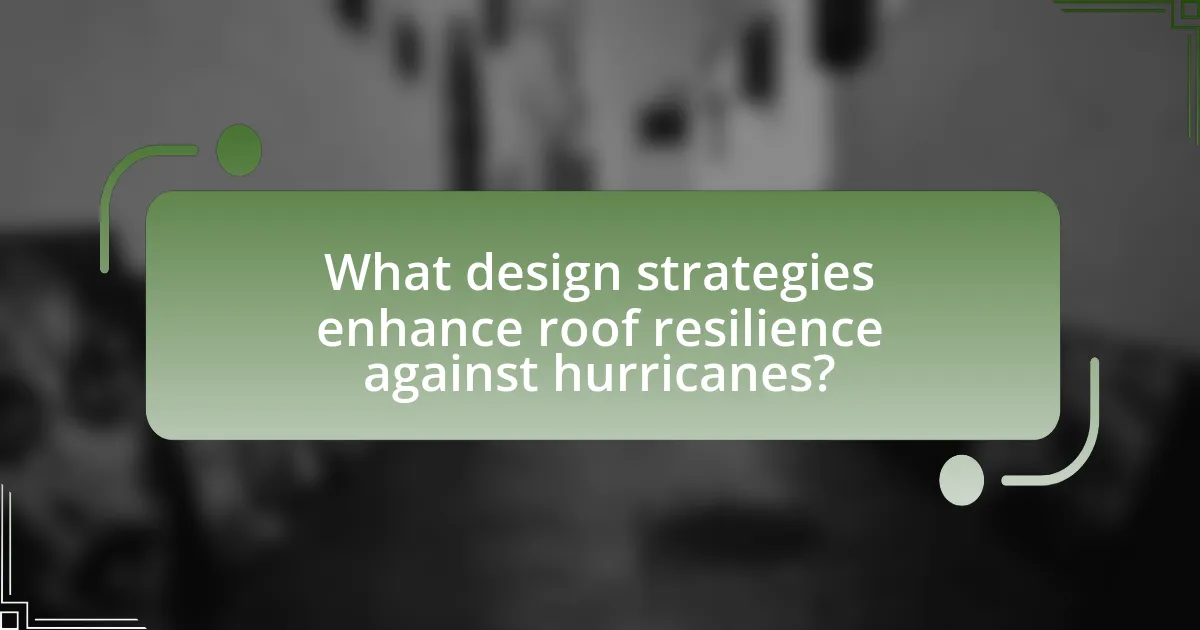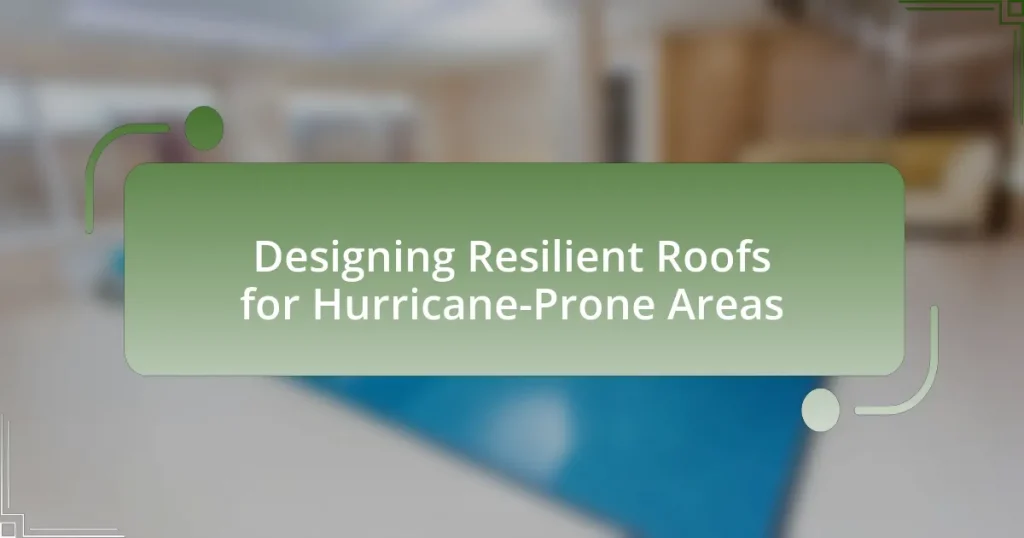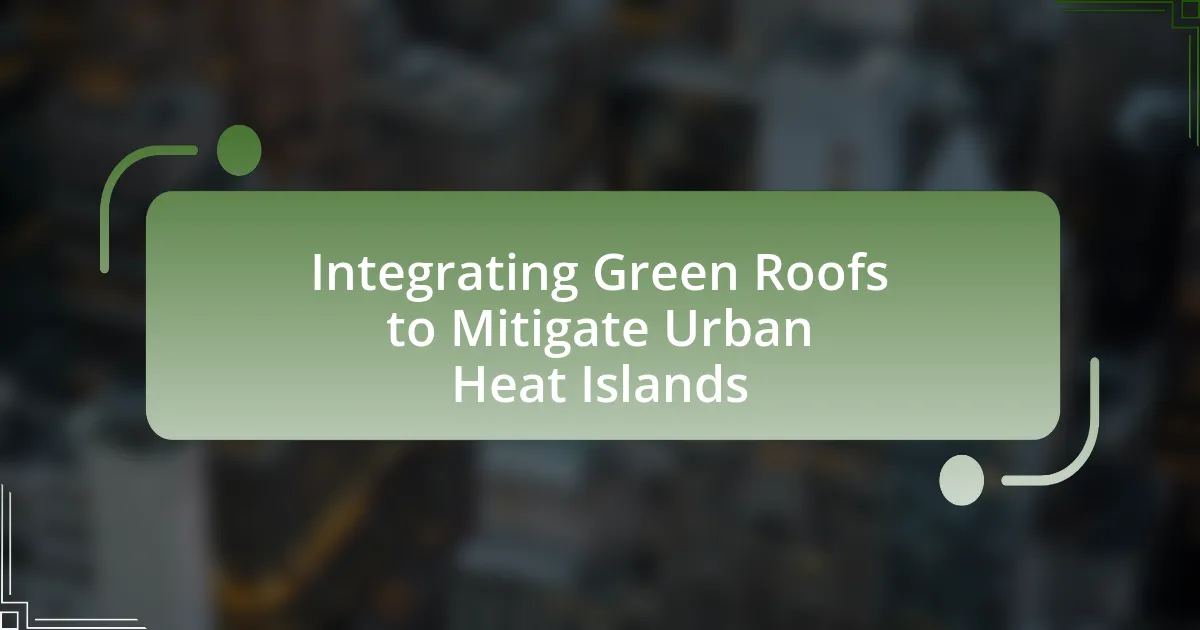The article focuses on designing resilient roofs for hurricane-prone areas, emphasizing key considerations such as material selection, structural integrity, and aerodynamic shape. It discusses the impact of wind forces on roof design, the implications of different wind speed categories, and the advantages of using materials like metal roofing over asphalt shingles. Additionally, the article highlights the importance of adhering to building codes, effective drainage systems, and innovative technologies that enhance roof resilience. It also addresses common challenges, maintenance practices, and cost-benefit considerations for homeowners aiming to ensure their roofs are prepared for severe weather events.

What are the key considerations in designing resilient roofs for hurricane-prone areas?
Key considerations in designing resilient roofs for hurricane-prone areas include material selection, structural integrity, and aerodynamic shape. Using materials such as metal or impact-resistant shingles enhances durability against high winds and flying debris. Structural integrity is crucial; roofs must be securely anchored to withstand uplift forces, with proper connections between trusses and sheathing. Additionally, an aerodynamic shape minimizes wind resistance, reducing the likelihood of roof failure during storms. According to the National Hurricane Center, roofs designed with these considerations can significantly reduce damage and repair costs during hurricanes.
How do wind forces impact roof design in hurricane-prone regions?
Wind forces significantly influence roof design in hurricane-prone regions by necessitating structural integrity and aerodynamic efficiency. Roofs must be designed to withstand high wind speeds, often exceeding 150 miles per hour during hurricanes, which can lead to uplift forces that threaten roof stability. Engineers implement features such as low slopes, reinforced materials, and secure fastening systems to minimize wind resistance and prevent roof failure. For instance, the Florida Building Code mandates specific design criteria for roofs in hurricane zones, ensuring that structures can endure the extreme conditions associated with hurricanes. This approach reduces the risk of damage and enhances the overall resilience of buildings in these vulnerable areas.
What are the different wind speed categories and their implications for roof design?
Wind speed categories are classified by the Saffir-Simpson Hurricane Wind Scale, which includes five categories ranging from 1 to 5, with corresponding wind speeds of 74-95 mph, 96-110 mph, 111-129 mph, 130-156 mph, and 157 mph or higher. Each category has significant implications for roof design; for instance, roofs in areas prone to Category 3 or higher hurricanes must be designed to withstand higher wind pressures and uplift forces, necessitating stronger materials and secure fastening systems. Research indicates that roofs designed to meet the standards for higher wind categories can reduce damage and improve structural integrity during severe weather events, as evidenced by the National Hurricane Center’s guidelines on building codes and wind resistance.
How can roof shape and slope influence wind resistance?
Roof shape and slope significantly influence wind resistance by affecting how wind flows over and around the structure. Steeper slopes, such as gable roofs, allow wind to slide off more easily, reducing uplift forces, while flatter roofs can trap wind and increase pressure, leading to potential structural failure. Research indicates that aerodynamic shapes, like hip roofs, can minimize wind load by directing airflow smoothly, thereby enhancing stability during high winds, as evidenced by studies from the National Institute of Standards and Technology, which demonstrate that roof design plays a critical role in mitigating wind damage in hurricane-prone areas.
What materials are best suited for hurricane-resistant roofs?
Metal roofing materials, such as galvanized steel and aluminum, are best suited for hurricane-resistant roofs due to their durability and ability to withstand high winds. These materials are less likely to be lifted or damaged during severe storms compared to traditional asphalt shingles, which can be torn off by strong gusts. Additionally, metal roofs can be installed with interlocking panels that enhance their resistance to wind uplift. According to the Federal Alliance for Safe Homes, metal roofs can endure wind speeds of up to 140 miles per hour, making them a reliable choice for hurricane-prone areas.
What are the advantages of using metal roofing in hurricane-prone areas?
Metal roofing offers significant advantages in hurricane-prone areas due to its durability and resistance to extreme weather conditions. Metal roofs can withstand high winds, often exceeding 140 mph, which is crucial in hurricane scenarios. Additionally, metal roofing is less likely to be damaged by flying debris, a common hazard during storms. The lightweight nature of metal roofing reduces the risk of structural failure, and its interlocking panels provide enhanced protection against water infiltration. Studies have shown that metal roofs can last 40 to 70 years, significantly outlasting traditional roofing materials, which is vital for long-term resilience in hurricane-affected regions.
How do asphalt shingles compare to other roofing materials in terms of resilience?
Asphalt shingles generally offer moderate resilience compared to other roofing materials like metal, tile, or slate. While asphalt shingles can withstand wind speeds up to 60-80 mph, metal roofing can endure winds exceeding 140 mph, making it more suitable for hurricane-prone areas. Additionally, asphalt shingles are more susceptible to damage from hail and extreme temperatures than materials such as tile or slate, which are known for their durability and longevity. According to the National Roofing Contractors Association, asphalt shingles have a lifespan of 15-30 years, whereas metal roofs can last 40-70 years, further highlighting the differences in resilience.
What building codes and regulations should be considered for hurricane-resistant roofs?
Hurricane-resistant roofs must adhere to specific building codes and regulations, primarily the International Building Code (IBC) and local amendments that address wind load requirements. The IBC outlines minimum design standards for structural integrity, including wind resistance, which is crucial in hurricane-prone areas. Additionally, the Florida Building Code (FBC) is a notable example of a local regulation that mandates enhanced roofing materials and installation techniques to withstand high winds, often requiring roofs to meet a minimum wind speed rating of 180 mph. Compliance with these codes ensures that roofs can endure the extreme conditions associated with hurricanes, thereby reducing damage and enhancing safety.
How do local building codes vary in hurricane-prone areas?
Local building codes in hurricane-prone areas are typically more stringent than those in non-hurricane regions, focusing on enhanced structural integrity and wind resistance. These codes often require specific materials, construction techniques, and design features to withstand high winds and flying debris, such as reinforced roofs, impact-resistant windows, and elevated foundations. For example, Florida’s building code mandates that structures in high-velocity hurricane zones must meet specific wind load requirements, which can exceed 180 mph, reflecting the need for resilience against severe storms.
What are the key standards for roof construction in hurricane zones?
The key standards for roof construction in hurricane zones include adherence to building codes that specify wind resistance, material durability, and structural integrity. These standards often require roofs to be designed to withstand wind speeds of at least 150 mph, as outlined in the International Building Code (IBC) and the Florida Building Code (FBC). Additionally, roofs must utilize materials such as impact-resistant shingles or metal roofing, which are proven to perform better under extreme weather conditions. The National Oceanic and Atmospheric Administration (NOAA) emphasizes that proper installation techniques, including secure fastening and adequate slope, are critical to prevent roof failure during hurricanes.

What design strategies enhance roof resilience against hurricanes?
Design strategies that enhance roof resilience against hurricanes include using materials with high wind resistance, implementing aerodynamic shapes, and ensuring proper anchoring systems. High wind-resistant materials, such as metal or impact-resistant shingles, can withstand extreme wind speeds, reducing the likelihood of roof failure. Aerodynamic roof designs, like hip roofs, minimize wind uplift by allowing wind to flow over the structure rather than exerting pressure on flat surfaces. Additionally, proper anchoring systems, including hurricane straps and clips, secure the roof to the walls and foundation, preventing detachment during severe storms. These strategies collectively contribute to the overall durability and safety of roofs in hurricane-prone areas.
How can roof anchoring techniques improve structural integrity?
Roof anchoring techniques enhance structural integrity by securely fastening the roof to the building’s framework, thereby reducing the risk of roof failure during extreme weather events. These techniques, such as the use of hurricane ties and straps, distribute wind loads more evenly across the structure, minimizing the likelihood of uplift and detachment. Research indicates that buildings with properly anchored roofs experience significantly lower damage rates in hurricanes, with studies showing that homes employing these techniques can withstand wind speeds exceeding 150 miles per hour without structural compromise.
What types of fasteners are recommended for hurricane-resistant roofs?
Hurricane-resistant roofs are best secured with specific types of fasteners, including stainless steel screws, hurricane clips, and structural screws. Stainless steel screws are recommended due to their corrosion resistance and strength, which are crucial in high-wind conditions. Hurricane clips provide additional support by connecting the roof to the walls, enhancing structural integrity during storms. Structural screws are designed to withstand significant shear forces, making them ideal for securing roofing materials. These fasteners are essential for maintaining the roof’s stability and preventing damage during hurricanes, as evidenced by building codes and standards that emphasize their use in hurricane-prone areas.
How does proper installation affect roof performance during hurricanes?
Proper installation significantly enhances roof performance during hurricanes by ensuring structural integrity and resistance to high winds. When roofs are installed according to manufacturer specifications and local building codes, they are more likely to withstand the extreme forces generated by hurricane conditions. For instance, studies have shown that roofs with proper fastening techniques, such as using hurricane straps and adequate nailing patterns, can reduce wind uplift and prevent roof failure. According to the Federal Alliance for Safe Homes, homes with well-installed roofs are 50% less likely to sustain severe damage during hurricanes compared to those with poorly installed roofs.
What role does drainage play in roof design for hurricane-prone areas?
Drainage is critical in roof design for hurricane-prone areas as it prevents water accumulation, which can lead to structural damage and roof failure during intense storms. Effective drainage systems, such as sloped roofs and strategically placed gutters, facilitate the rapid removal of rainwater, reducing the risk of leaks and water intrusion. According to the National Oceanic and Atmospheric Administration (NOAA), roofs designed with proper drainage can withstand wind-driven rain, a common occurrence in hurricanes, thereby enhancing the overall resilience of the structure.
How can effective drainage systems prevent roof damage during heavy rains?
Effective drainage systems prevent roof damage during heavy rains by efficiently channeling water away from the roof surface, thereby reducing the risk of water accumulation and subsequent leaks. When heavy rains occur, roofs can become overwhelmed with water, leading to potential structural damage, mold growth, and deterioration of roofing materials. A well-designed drainage system, including gutters, downspouts, and proper roof slope, ensures that rainwater is directed away from the roof and foundation, minimizing the likelihood of pooling and the associated risks. Studies have shown that roofs with effective drainage systems can reduce water-related damage by up to 50%, highlighting the importance of proper drainage in maintaining roof integrity during severe weather events.
What design features enhance water runoff and minimize pooling?
Sloped roofs enhance water runoff and minimize pooling by directing rainwater towards gutters and downspouts. The angle of the slope is crucial; a minimum pitch of 2:12 is recommended to ensure effective drainage. Additionally, materials such as metal or asphalt shingles with smooth surfaces facilitate quick water flow, reducing the risk of pooling. Properly designed gutters and downspouts, sized according to the roof area and local rainfall intensity, further support efficient water management. These features collectively contribute to the longevity and resilience of roofs in hurricane-prone areas by preventing water accumulation that can lead to structural damage.
What innovative technologies are available for hurricane-resistant roofing?
Innovative technologies available for hurricane-resistant roofing include impact-resistant shingles, metal roofing systems, and advanced synthetic materials. Impact-resistant shingles are designed to withstand high winds and flying debris, often meeting the standards set by the Underwriters Laboratories (UL) for impact resistance. Metal roofing systems provide durability and can be installed with interlocking panels to enhance wind resistance. Advanced synthetic materials, such as polymer-based roofing, offer flexibility and strength, allowing them to endure extreme weather conditions. These technologies collectively contribute to the structural integrity and longevity of roofs in hurricane-prone areas.
How do impact-resistant materials contribute to roof resilience?
Impact-resistant materials enhance roof resilience by providing superior protection against severe weather conditions, particularly in hurricane-prone areas. These materials, such as impact-resistant shingles and metal roofing, are designed to withstand high winds and flying debris, significantly reducing the risk of roof damage during storms. For instance, studies have shown that roofs made from impact-resistant materials can endure wind speeds of up to 130 mph, compared to traditional roofing materials that may fail at lower speeds. This durability not only prolongs the lifespan of the roof but also minimizes repair costs and potential structural damage to the building, thereby contributing to overall safety and resilience in extreme weather events.
What advancements in roofing technology are being developed for hurricane protection?
Advancements in roofing technology for hurricane protection include the development of impact-resistant materials, aerodynamic roof designs, and advanced fastening systems. Impact-resistant materials, such as modified bitumen and reinforced shingles, are engineered to withstand high winds and flying debris, significantly reducing roof damage during hurricanes. Aerodynamic roof designs minimize wind uplift by allowing airflow to pass over the structure, thereby decreasing pressure differentials that can lead to roof failure. Advanced fastening systems, including hurricane straps and clips, enhance the structural integrity of roofs by securely anchoring them to the building frame, which is crucial in high-wind scenarios. These innovations collectively aim to improve the resilience of roofs in hurricane-prone areas, as evidenced by studies showing that homes with these technologies experience lower rates of damage during severe storms.

What are the common challenges in designing roofs for hurricane-prone areas?
Common challenges in designing roofs for hurricane-prone areas include ensuring structural integrity against high winds, preventing water intrusion, and selecting appropriate materials. High winds can exceed 150 mph during hurricanes, necessitating roofs that can withstand such forces without failing. Water intrusion is a critical concern, as heavy rainfall can lead to leaks and structural damage; thus, effective drainage systems and waterproof materials are essential. Additionally, the choice of materials must balance durability and weight, as lighter materials may be more susceptible to wind damage, while heavier materials can impose additional stress on the structure. These challenges require careful consideration of engineering principles and local building codes to enhance resilience against hurricanes.
What are the most frequent failures observed in hurricane-damaged roofs?
The most frequent failures observed in hurricane-damaged roofs include shingle loss, structural damage, and water infiltration. Shingle loss occurs when high winds dislodge roofing materials, leading to exposed areas that can result in leaks. Structural damage often involves the roof deck being compromised due to extreme wind forces or debris impact, which can lead to partial or total roof collapse. Water infiltration is a critical issue that arises when roofing materials are damaged, allowing rainwater to penetrate the interior, causing further damage to the building’s structure and contents. These failures are documented in studies such as the “Hurricane Damage Assessment” by the National Oceanic and Atmospheric Administration, which highlights the vulnerability of roofs to severe weather conditions.
How can design flaws lead to roof failure during hurricanes?
Design flaws can lead to roof failure during hurricanes by compromising structural integrity and wind resistance. For instance, inadequate anchoring of roof components can result in the roof being lifted off by high winds, as seen in the aftermath of Hurricane Andrew in 1992, where poorly designed roofs were a significant factor in widespread damage. Additionally, improper slope or drainage design can cause water accumulation, increasing the risk of leaks and structural weakening. Research indicates that roofs designed without consideration for local wind speeds and patterns are more susceptible to failure, highlighting the importance of adhering to building codes and standards specific to hurricane-prone areas.
What maintenance practices can prevent roof damage in hurricane-prone areas?
Regular inspections and timely repairs are essential maintenance practices that can prevent roof damage in hurricane-prone areas. Conducting biannual inspections allows homeowners to identify and address issues such as loose shingles, damaged flashing, or clogged gutters before a hurricane strikes. According to the National Oceanic and Atmospheric Administration, roofs that are well-maintained can withstand winds of up to 130 mph, significantly reducing the risk of damage during severe storms. Additionally, reinforcing roof structures with hurricane straps and ensuring proper drainage systems are in place further enhance resilience against hurricane conditions.
How does cost impact the design of resilient roofs?
Cost significantly influences the design of resilient roofs by determining the materials, construction methods, and technologies that can be utilized. Higher costs often lead to the selection of more durable materials, such as impact-resistant shingles or reinforced structures, which enhance a roof’s ability to withstand extreme weather conditions. For instance, a study by the National Institute of Building Sciences indicates that investing in resilient roofing can reduce long-term repair and replacement costs by up to 50% after a hurricane. Therefore, while initial expenses may be higher, the long-term financial benefits and increased safety justify the investment in resilient roof designs.
What are the cost-benefit considerations for investing in hurricane-resistant roofing?
Investing in hurricane-resistant roofing involves weighing the initial higher costs against long-term benefits such as reduced damage and lower insurance premiums. The upfront investment for materials and installation can be 20-30% more than standard roofing options; however, these roofs can withstand winds of up to 180 mph, significantly decreasing the likelihood of costly repairs or replacements after a hurricane. Additionally, homeowners may benefit from insurance discounts, as many insurers offer lower premiums for properties with hurricane-resistant features, potentially saving thousands over time. Studies indicate that homes with such roofing can retain higher resale values, further enhancing the financial justification for the investment.
How can homeowners balance budget constraints with the need for resilience?
Homeowners can balance budget constraints with the need for resilience by prioritizing essential upgrades and utilizing cost-effective materials that enhance structural integrity. For instance, investing in impact-resistant roofing materials, such as metal or asphalt shingles, can reduce long-term repair costs and insurance premiums, as studies show that resilient roofs can withstand hurricane winds better than traditional options. Additionally, homeowners can seek local or federal grants aimed at improving disaster resilience, which can alleviate upfront costs while ensuring their homes are better equipped to handle extreme weather events.
What practical tips can homeowners follow to ensure their roofs are hurricane-ready?
Homeowners can ensure their roofs are hurricane-ready by reinforcing roof structures, using impact-resistant materials, and maintaining proper drainage systems. Reinforcing roof structures involves securing roof sheathing with nails spaced closer together to withstand high winds. Utilizing impact-resistant materials, such as metal or specially designed shingles, can prevent damage from flying debris. Additionally, maintaining proper drainage systems, including gutters and downspouts, helps prevent water accumulation that can lead to roof failure during heavy rains associated with hurricanes. These practices are supported by the Federal Emergency Management Agency (FEMA), which emphasizes the importance of strong roofing systems in hurricane-prone areas.




